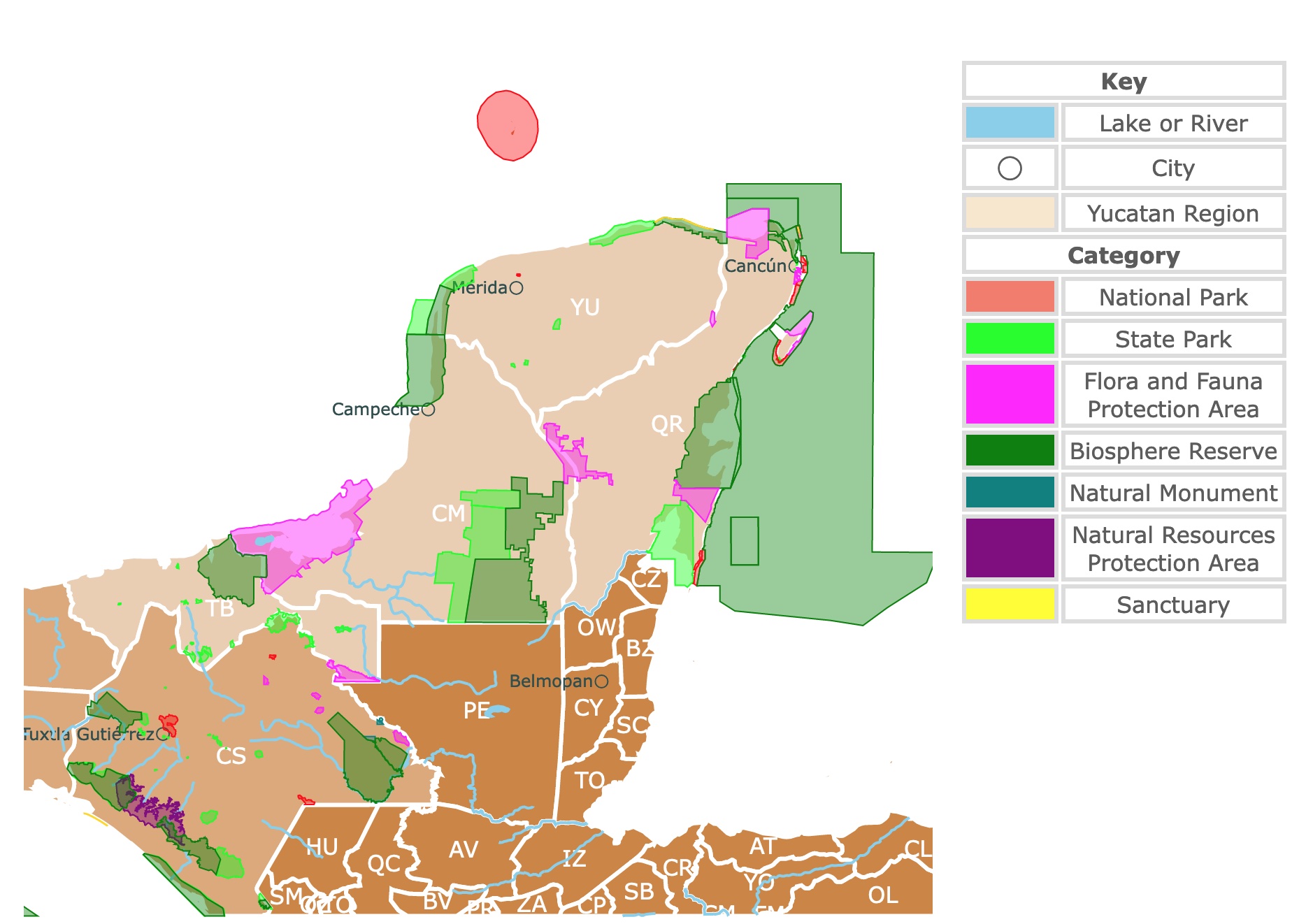The Enduring Bounty: Exploring the Diverse Natural Resources of Yucatán
The Yucatán Peninsula, a land of ancient Maya civilization and breathtaking natural beauty, holds a wealth of natural resources that have shaped its history and continue to influence its present. This unique region, encompassing the Mexican states of Yucatán, Campeche, and Quintana Roo, boasts a complex interplay of geology, climate, and biodiversity, resulting in a rich tapestry of resources that sustain its ecosystems and communities.
The Limestone Platform: A Foundation of Porosity
The Yucatán Peninsula is essentially a vast, flat limestone platform. This geological foundation is crucial to understanding the region’s unique hydrology and resource distribution. The limestone, being highly porous, readily absorbs rainwater, creating an intricate network of underground rivers and cenotes (sinkholes).
Cenotes: Windows to the Subterranean World

These cenotes, formed by the collapse of limestone cave roofs, are not only visually stunning but also vital freshwater sources. They represent a unique ecosystem, supporting diverse aquatic life and providing access to the vast underground aquifer. For the Maya, cenotes held spiritual significance, serving as entrances to the underworld.
The Absence of Surface Rivers: Dependence on Groundwater
Due to the porous limestone, the Yucatán lacks significant surface rivers. This makes groundwater, stored in the aquifer, the primary source of freshwater for both human consumption and agriculture. The delicate balance of this aquifer is crucial, as over-extraction and contamination pose serious threats.
Tropical Forests: A Haven for Flora and Fauna
The Yucatán Peninsula is home to diverse tropical forests, including rainforests, deciduous forests, and mangroves. These forests harbor a rich array of plant and animal species, many of which are endemic to the region. They provide essential ecosystem services, such as carbon sequestration, soil stabilization, and habitat provision.
The Mesoamerican Barrier Reef: A Marine Treasure

Off the coast of the Yucatán Peninsula lies the Mesoamerican Barrier Reef, the second-largest barrier reef system in the world. This vibrant ecosystem supports a vast array of marine life, including coral species, fish, marine mammals, and sea turtles. It is a crucial resource for tourism, fishing, and coastal protection.
Mangroves: Coastal Guardians
Mangrove forests, found along the coastlines, play a critical role in protecting shorelines from erosion, filtering pollutants, and providing breeding grounds for numerous marine species. They are essential for maintaining the health of coastal ecosystems and supporting fisheries.
Freshwater: The Lifeblood of the Peninsula
Groundwater: The Primary Source
As mentioned earlier, groundwater is the most important natural resource in the Yucatán. Its availability and quality are crucial for agriculture, tourism, and domestic use. The management of this resource is a critical challenge, requiring sustainable extraction practices and pollution control measures.
Rainwater Harvesting: A Traditional Practice
Rainwater harvesting has been a traditional practice in the Yucatán, particularly in areas where access to groundwater is limited. This practice involves collecting and storing rainwater for various uses, such as irrigation and domestic consumption.
The Challenge of Saline Intrusion: Protecting Coastal Aquifers
Saline intrusion, the contamination of freshwater aquifers by seawater, is a growing concern in coastal areas of the Yucatán. Over-extraction of groundwater and sea-level rise exacerbate this problem, impacting the availability of freshwater for local communities.
Forest Resources: Timber, Chicle, and Medicinal Plants
Timber: Sustainable Forestry Practices
The forests of the Yucatán have historically been a source of timber, particularly hardwoods such as mahogany and cedar. Sustainable forestry practices are essential to ensure the long-term availability of these resources and protect forest ecosystems.
Chicle: A Natural Gum from the Sapodilla Tree
Chicle, a natural gum derived from the sapodilla tree, was once a major export from the Yucatán. While its importance has declined with the rise of synthetic gums, it remains a traditional resource with potential for sustainable harvesting.
Medicinal Plants: Traditional Maya Knowledge
The Maya people have a rich tradition of using medicinal plants for healing. This knowledge, passed down through generations, represents a valuable resource for traditional medicine and potential pharmaceutical applications.
Marine Resources: Fisheries and Tourism
Fisheries: A Vital Source of Livelihood
The coastal waters of the Yucatán support a diverse range of fisheries, including lobster, shrimp, and finfish. These fisheries are an important source of livelihood for coastal communities. Sustainable fishing practices are essential to prevent overfishing and maintain the health of marine ecosystems.
Tourism: A Major Economic Driver
The natural beauty of the Yucatán Peninsula, including its beaches, cenotes, and coral reefs, makes it a popular tourist destination. Tourism is a major economic driver, but it also poses challenges for resource management and environmental protection.
Mineral Resources: Salt and Limestone
Salt: A Traditional Resource
Salt production has been a traditional activity in the Yucatán, particularly in coastal areas. Salt pans are used to evaporate seawater, leaving behind salt crystals.
Limestone: Building Material and Aggregate
Limestone is abundant in the Yucatán and is used as a building material and aggregate for construction. Its extraction, however, can have environmental impacts, such as habitat destruction and groundwater contamination.
Deforestation and Habitat Loss: Protecting Biodiversity
Deforestation and habitat loss are major threats to the biodiversity of the Yucatán Peninsula. The expansion of agriculture, tourism development, and infrastructure projects contribute to this problem. Protecting forests and other natural habitats is essential for conserving biodiversity and maintaining ecosystem services.
Water Resource Management: Ensuring Sustainable Use
Sustainable water resource management is a critical challenge in the Yucatán. Over-extraction of groundwater, pollution, and saline intrusion threaten the availability and quality of freshwater. Integrated water resource management strategies are needed to ensure the long-term sustainability of this vital resource.
Climate Change: Impacts and Adaptation
Climate change poses significant risks to the natural resources of the Yucatán Peninsula. Sea-level rise, increased frequency and intensity of storms, and changes in rainfall patterns can impact coastal ecosystems, freshwater resources, and agricultural productivity. Adaptation measures are needed to mitigate these impacts.
Ecotourism: Promoting Sustainable Development
Ecotourism, which emphasizes responsible travel to natural areas, has the potential to promote sustainable development in the Yucatán. By supporting local communities and conserving natural resources, ecotourism can contribute to the long-term well-being of the region.
Traditional Knowledge: Integrating Maya Wisdom
Integrating traditional Maya knowledge into resource management practices can provide valuable insights into sustainable use and conservation. The Maya people have a deep understanding of the local ecosystems and have developed sustainable practices that have been passed down through generations.
The natural resources of the Yucatán Peninsula are a precious heritage that must be carefully managed for the benefit of present and future generations. By embracing sustainable practices, integrating traditional knowledge, and addressing the challenges posed by climate change, the Yucatán can ensure the enduring bounty of its natural resources.


